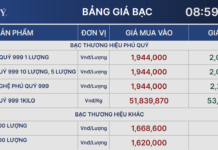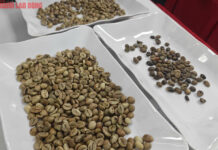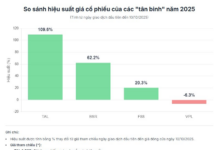US July PCE inflation data meets expectations, reducing market hopes for a strong Fed rate cut in September, pushing gold prices down.
On Friday (30/8), spot gold fell 0.9% to $2,497.53 per ounce, falling below the $2,500 per ounce mark and retreating from its all-time high of $2,531.60 reached on August 20. However, gold prices still gained 2% in August, making it a month of impressive volatility.
Domestic gold prices fluctuated last week, but overall, there was little change from the previous week. SJC gold bars are currently trading at VND 79-81 million per tael (buy-sell), similar to a week ago, while SJC 9999 gold rings are at VND 77.4-78.65 million per tael (buy-sell), only slightly different from the VND 77-78.5 million per tael range a week earlier.
Data released by the US Department of Commerce on Friday showed that the Personal Consumption Expenditures (PCE) Price Index, the country’s preferred inflation measure, rose 0.2% in July, in line with economists’ forecasts. This indicates that the world’s largest economy remains robust despite higher interest rates. As a result, the Fed may need to reconsider the magnitude of its rate cut at the upcoming meeting to balance its dual mandate of price stability and economic growth.

Gold price movement in August
The Kitco News survey showed that retail investors are tempering their recent optimism about gold’s prospects, while experts are becoming more cautious in their market forecasts.
“Prices will go up,” said Adrian Day, chairman of Adrian Day Asset Management, one of the bulls on gold’s outlook. “As we get closer to the Fed cutting rates, the momentum for gold could pick up. Just the first rate cut in the cycle has been a buy signal for gold. This has been proven over the past 20 years,” he added.
“I think gold prices will decline next week,” said Marc Chandler, chief market strategist at Bannockburn Global Forex. “The upward momentum has stalled. The US dollar could rebound and sustain its longer-term strength. I predict gold will head towards the $2,470-75 level.”
“Prices will consolidate,” said Darin Newsom, a senior analyst at Barchart.com. “The daily chart of December gold futures through the end of August showed no clear direction. Therefore, I predict that gold prices will trade sideways next week, with the possibility of a breakout in either direction.”
Phillip Streible, chief market strategist at Blue Line Futures, was bearish on gold’s prospects but noted that any correction would likely be mild, and a price dip would present a buying opportunity. He added that September has historically been a poor month for gold, so traders should look for buying opportunities but refrain from over-leveraging.
Bob Haberkorn, senior commodity broker at RJO Futures, anticipated a sideways price movement next week. “Two thousand five hundred dollars is a reasonable level, and naturally, this will be the point that people will trade around,” he said. “People are looking to buy below $2,500, and the way the market moves with stop and limit orders, prices will naturally trade around that level, but I think $2,480 is likely to be the support.”
According to Haberkorn, the decline in gold prices on Friday was solely due to a stronger US dollar, and it reflected a risk-averse sentiment ahead of the long holiday weekend. In summary, “that’s the feeling of all markets right now (not just gold), people are just liquidating some contracts to wait and see next week.”
Regarding the US employment data to be released next Friday, Haberkorn said that even if the non-farm payrolls report disappoints, it is highly unlikely that the Fed will cut interest rates by 50 basis points at the start of its easing cycle.
“I think there’s too much pressure building for a rate cut right now. Mr. Powell has signaled that it will happen, and the market won’t be surprised. But a 50-basis-point reduction is very unlikely,” he added.
Haberkorn suggested that the most probable scenario is a single 25-basis-point cut, followed by a pause to assess the impact. “Inflation is still high, people are still feeling the pain of inflation, and I don’t think the Fed’s job is done yet,” he remarked.
He further added, “If it weren’t an election year, I think the Fed would wait longer before cutting rates. But because we have an election coming up, and there’s a lot of political pressure to start cutting rates, I think the Fed will cut rates twice between now and November, each time by a quarter point.”
According to the FedWatch tool from CME Group on Friday, traders slightly increased their bets that the Fed will cut interest rates by 25 basis points in September to 69%, while the odds of a 50-basis-point reduction fell to 31% after the inflation report.
This week, 15 Wall Street analysts participated in the Kitco News Gold Survey. Among them, five analysts, or 33%, predicted gold prices to rise next week, while five analysts expected prices to fall, and five analysts foresaw a sideways market (a three-way tie).
Meanwhile, out of 199 votes cast in the online Main Street poll, 112 voters, or 56%, predicted that gold prices would rise next week. In contrast, 47 voters, or 24%, looked for lower prices, and 40 voters, or 20%, expected prices to trade sideways.

Kitco News survey results for the week of September 2 – 6
After a week dominated by anticipation of US inflation data, market participants will shift their focus to employment indicators next week as North American markets resume trading after the long holiday weekend.
On Tuesday (9/3), the market will receive data on the US August Manufacturing PMI, and on Wednesday (9/4), the Bank of Canada’s monetary policy decision and the US Job Openings report will be announced. Subsequently, on Thursday (9/5), traders will monitor the weekly US jobless claims and the US Services PMI.
However, the most notable event next week is the US nonfarm payrolls data, released on Friday morning (9/6). Some market experts believe that this data could be decisive in determining the magnitude of the Fed’s rate cut in September (25 or 50 basis points).
Reference: Kitco News
The Price of Gold Today: Unpredictable Trends and Volatility
Today, gold prices have taken another significant dip in the international market, hovering just above the $2,500/ounce mark as the US dollar strengthens.































